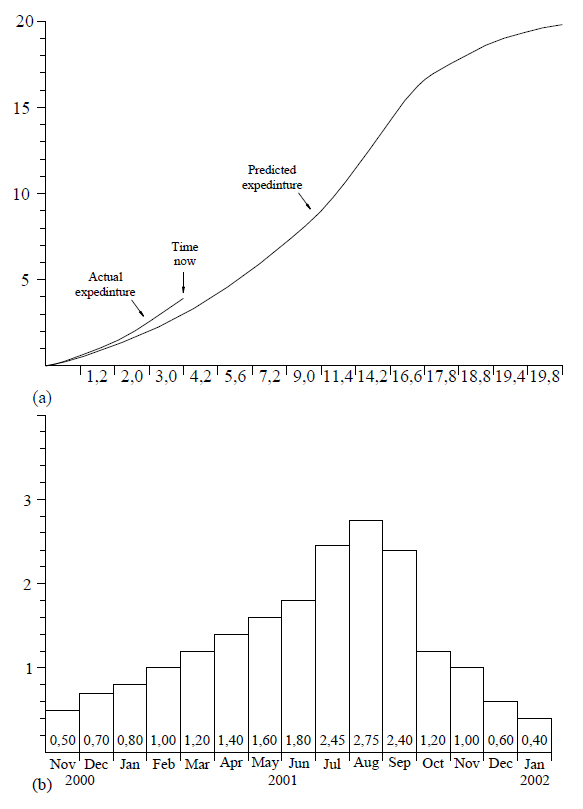Cost control in building design and construction
A development budget study is undertaken to determine the total costs and returns expected from the project. A cost plan is prepared to include all construction costs, all other items of project cost including professional fees and contingency.
All costs included in the cost plan will also be included in the development budget in addition to the developer’s returns and other extraneous items such as project insurance, surveys and agent’s or other specialist advisers’ fees.
The purpose of the cost plan is to allocate the budget to the main elements of the project to provide a basis for cost control. The terms budget and cost plan are often regarded as synonymous. However, the difference is that the budget is the limit of expenditure defined for the project, whereas the cost plan is the definition of what the money will be spent on and when.
The cost plan should, therefore, include the best possible estimate of the cash flow for the project and should also set targets for future running costs. The cost plan should cover all stages of the project and will be the essential reference against which the project costs are managed.
The method used to determine the budget will vary at different stages of the project, although the degree of certainty should increase as project elements become better defined. The budget should be based on the client’s business case and should change only if the business case changes. The aim of cost control is to produce the best possible building within the budget
The cost plan provides the basis for a cash flow plan, allocating expenditure and income to each period of the client’s financial year. The expenditures should be given at a stated base-date level and at out-turn levels based upon a stated forecast of inflation.
Figure: Examples of a construction expenditure graph and cash flow histogram.
The objective of cost control is to manage the delivery of the project within the approved budget. Regular cost reporting will facilitate, at all times, the best possible estimate of:
- Established project cost to date.
- Anticipated final cost of the project.
- Future cash flow.
In addition cost reporting may include assessments of:
Monitoring expenditure to any particular date does not exert any control over future expenditure and, therefore, the final cost of the project. Effective cost control is achieved when the whole of the project team adopts the correct attitude to cost.
Effective cost control will require the following actions to be taken:
-- Establishing that all decisions taken during design and construction are based on a forecast of the cost implications of the alternatives being considered, and that no decisions are taken whose cost implications would cause the total budget to be exceeded.
-- Encouraging the project team to design within the cost plan at all stages and follow the variation/change and design development control procedures for the project. It is generally acknowledged that 80% of cost is determined by design and 20% by construction. It is important that the project team is aware that no member of the team has the authority to increase costs on its section or element of the work. Increased costs on one item must always be balanced by savings on another.
-- Regularly updating and reissuing the cost plan and variation orders causing any alterations to the brief.
-- Adjusting the cash flow plan to reflect alterations in the target cost, the master schedule or the forecast of inflation.
-- Developing the cost plan in liaison with the project team as design and construction progress. At all times it should comprise the best possible estimate of the final cost of the project and of the future cash flow. Adherence to design freezes will aid cost control. Developing the cost plan also involves adding detail as more information about the work is assembled, replacing cost forecasts with more accurate forecasts or actual costs whenever better information can be obtained.
-- Reviewing contingency and risk allowances at intervals and reporting the assessments is an essential part of risk management procedures. Developing the cost plan should not involve increasing the total cost.
-- Checking that the agreed change management process is strictly followed at all stages of the project. The procedure should only be carried out retrospectively, and then only during the construction phase of the project, when it can be demonstrated that otherwise significant delay, cost or danger would have been incurred by awaiting responses.
-- Arranging for the contractor to be given the correct information at the correct time in order to minimise claims. Any anticipated or expected claims should be reported to the client and included in the regular cost reports.
-- Contingency provisions are based on a thorough evaluation of the risks and are available to pay for events which are unforeseen and unforeseeable. It should not be used to cover; changes in the specification, changes in the client’s requirements or variations resulting from errors or omissions. Should the consultants consider that there is no alternative but to exceed the budget, a written request must be submitted to the client and the correct authorisation received.
This must include the following:
- Details of variations leading to the request.
- Confirmation that the variations are essential.
- Confirmation that compensating savings are not possible without having an unacceptable effect on the quality or function of the completed project.
-- Submitting regular, up-to-date and accurate cost reports to keep the client well informed of the current budgetary and cost situation.
-- Ensuring that all parties are clear about the meaning of each entry in the cost report. No data should be incorrectly entered into the budget report or any incorrect deductions made from it.
-- Ensuring that the project costs are always reported back against the original approved budget. Any subsequent variations to the budget must be clearly indicated in the cost reports.
-- Plotting actual expenditure against predicted to give an indication of the project’s progress.
See also Change control.
The text in this article is based on an extract from PROJECT MANAGEMENT, by Eric Stokes and Saleem Akram. The original manual was published in 2008. It was developed within the scope of the LdV program, project number: 2009-1-PL1-LEO05-05016 entitled “Common Learning Outcomes for European Managers in Construction”. It is reproduced here in a slightly modified form with the kind permission of the Chartered Institute of Building.
--CIOB
[edit] Related articles on Designing Buildings
- Abortive work.
- Approximate quantities cost plan.
- Bills of quantities.
- Budget.
- Business plan.
- Change control.
- Change control: a quality perspective.
- Cost.
- Cost certainty.
- Cost consultant.
- Cost monitoring.
- Cost overruns.
- Cost plan.
- Cost reporting.
- Elemental cost plan.
- Estimator.
- Initial cost appraisal.
- Irrelevant cost.
- Net Present Value.
- New Rules of Measurement.
- Scope creep.
- Value engineering.
- Value management.
- Whole-life costs.
- Total Costs
Featured articles and news
RTPI leader to become new CIOB Chief Executive Officer
Dr Victoria Hills MRTPI, FICE to take over after Caroline Gumble’s departure.
Social and affordable housing, a long term plan for delivery
The “Delivering a Decade of Renewal for Social and Affordable Housing” strategy sets out future path.
A change to adoptive architecture
Effects of global weather warming on architectural detailing, material choice and human interaction.
The proposed publicly owned and backed subsidiary of Homes England, to facilitate new homes.
How big is the problem and what can we do to mitigate the effects?
Overheating guidance and tools for building designers
A number of cool guides to help with the heat.
The UK's Modern Industrial Strategy: A 10 year plan
Previous consultation criticism, current key elements and general support with some persisting reservations.
Building Safety Regulator reforms
New roles, new staff and a new fast track service pave the way for a single construction regulator.
Architectural Technologist CPDs and Communications
CIAT CPD… and how you can do it!
Cooling centres and cool spaces
Managing extreme heat in cities by directing the public to places for heat stress relief and water sources.
Winter gardens: A brief history and warm variations
Extending the season with glass in different forms and terms.
Restoring Great Yarmouth's Winter Gardens
Transforming one of the least sustainable constructions imaginable.
Construction Skills Mission Board launch sector drive
Newly formed government and industry collaboration set strategy for recruiting an additional 100,000 construction workers a year.
New Architects Code comes into effect in September 2025
ARB Architects Code of Conduct and Practice available with ongoing consultation regarding guidance.
Welsh Skills Body (Medr) launches ambitious plan
The new skills body brings together funding and regulation of tertiary education and research for the devolved nation.
Paul Gandy FCIOB announced as next CIOB President
Former Tilbury Douglas CEO takes helm.
UK Infrastructure: A 10 Year Strategy. In brief with reactions
With the National Infrastructure and Service Transformation Authority (NISTA).

























Comments
Cost control is a critical aspect of building design and construction to ensure that the project stays within the budget while meeting the desired quality and functionality. Here are some effective strategies for cost control in building design and construction:
1. **Thorough Planning and Budgeting:** Start with a detailed and well-defined project plan, including a comprehensive budget. Involve all stakeholders, including architects, engineers, contractors, and clients, in the planning process to set clear objectives and cost expectations.
2. **Value Engineering:** Implement value engineering during the design phase to identify cost-saving opportunities without compromising on the project's functionality and quality. This involves evaluating alternatives for materials, construction methods, and design elements to find the most cost-effective solutions.
3. **Regular Cost Estimation and Monitoring:** Continuously estimate and monitor project costs throughout the design and construction phases. Regularly compare actual costs to the budget and adjust the plan accordingly to avoid cost overruns.
4. **Early Contractor Involvement:** Involve contractors and subcontractors early in the design process to get their input on cost-effective construction methods and materials. Their expertise can help identify potential cost-saving measures.
5. **Material Selection:** Choose materials that strike a balance between cost and quality. Consider using cost-effective, yet durable and energy-efficient materials that meet the project's requirements.
6. **Standardization and Prefabrication:** Standardize components and use prefabrication whenever possible. Prefabricated elements can save time and labor costs during construction.
7. **Bidding Process:** Implement a competitive bidding process to get the best prices from contractors and suppliers. Ensure that the bids are well-documented and include clear specifications.
8. **Contingency Fund:** Set aside a contingency fund in the budget to account for unforeseen expenses and potential scope changes.
9. **Energy Efficiency:** Incorporate energy-efficient design features and technologies to reduce long-term operational costs and environmental impact.
10. **Project Management and Communication:** Effective project management and open communication among all stakeholders can help identify potential cost issues early and address them proactively.
11. **Quality Control and Risk Management:** Emphasize quality control measures to minimize rework and avoid costly mistakes. Implement risk management strategies to anticipate and mitigate potential risks that could impact costs.
12. **Lifecycle Cost Analysis:** Consider the lifecycle cost of the building, including maintenance, operation, and energy costs, to make informed decisions about cost-effective design and construction choices.
By employing these cost control strategies throughout the design and construction process, project stakeholders can optimize project budgets, ensure timely completion, and deliver a successful building that meets the client's needs and expectations.